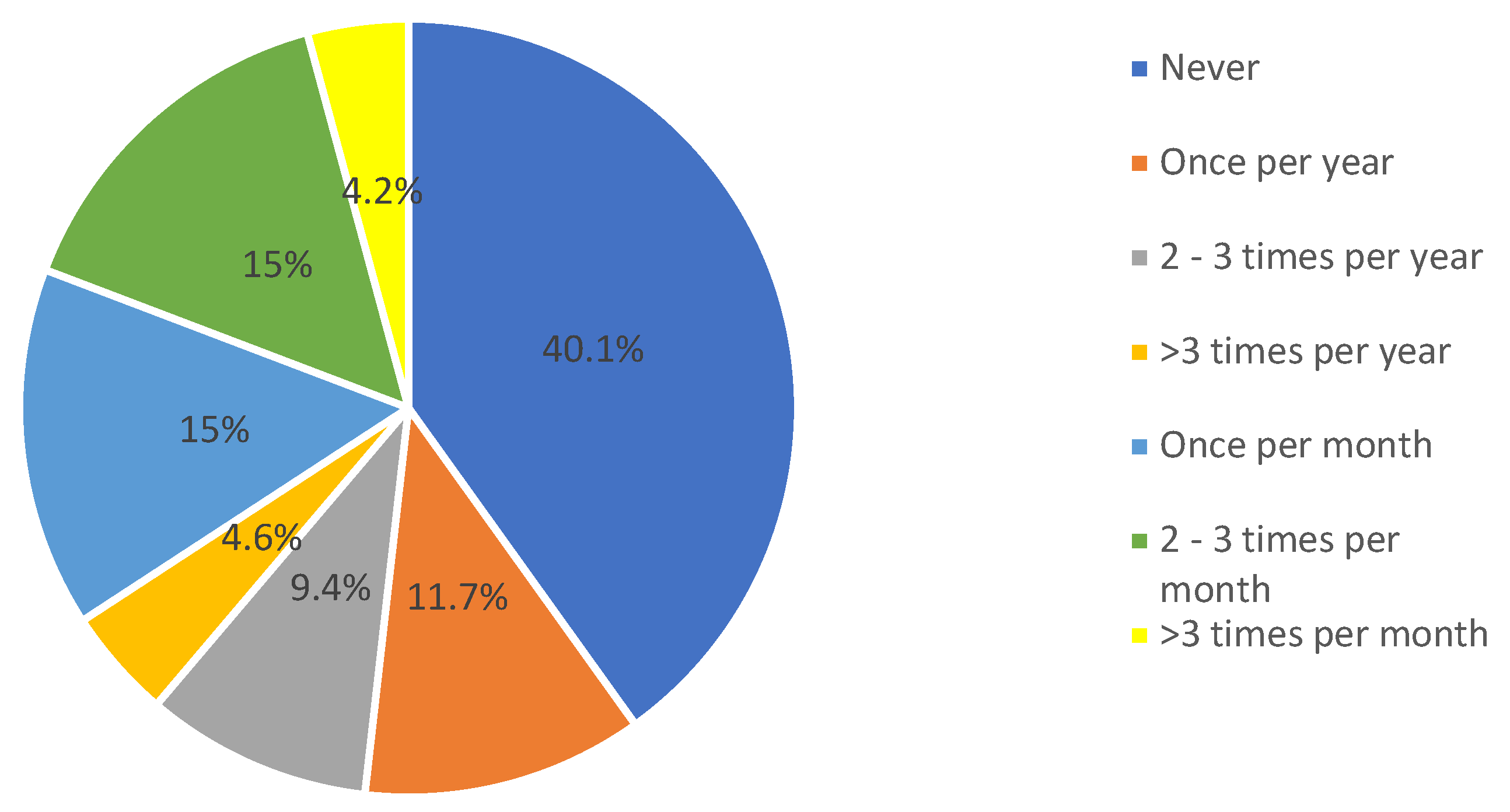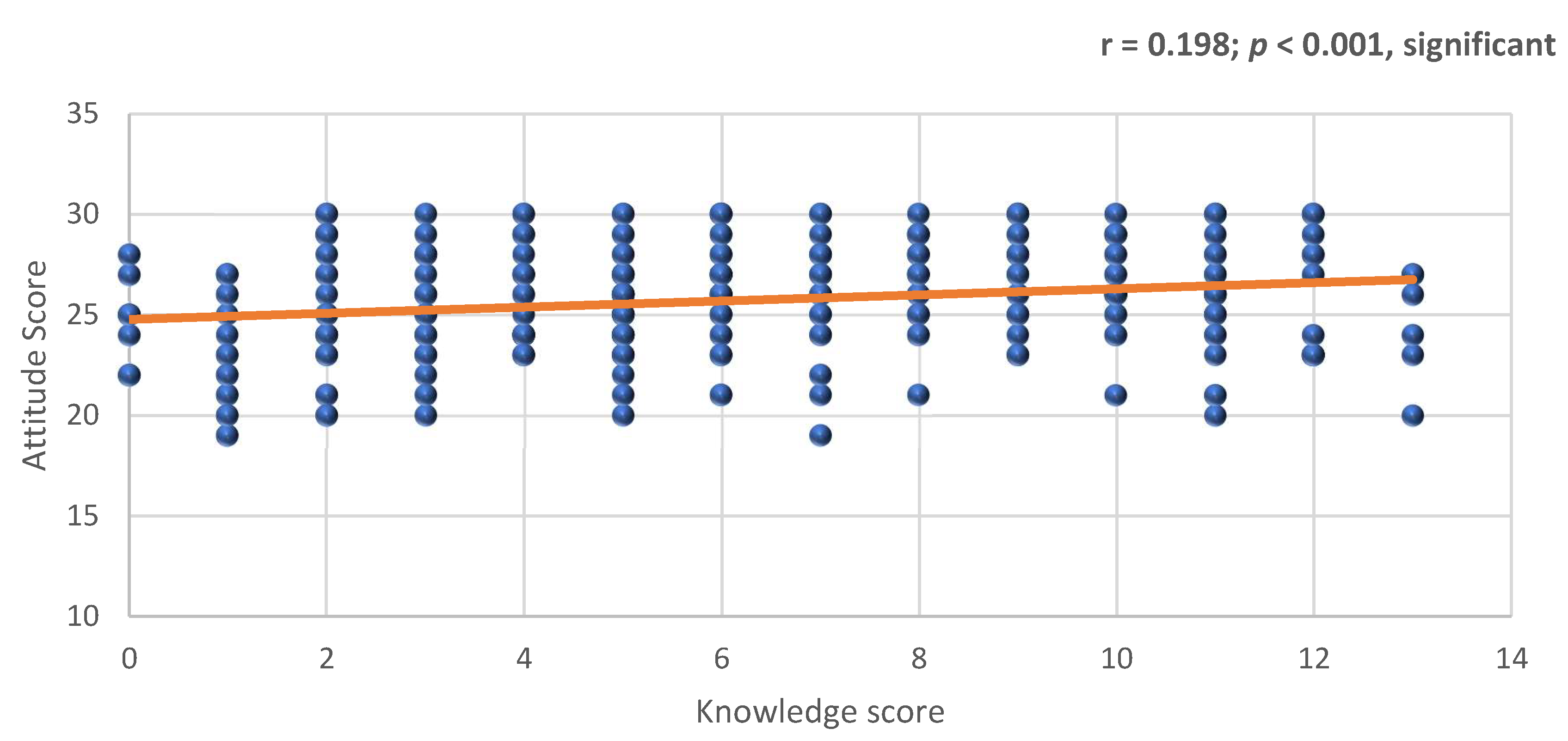Are Physicians in Saudi Arabia Ready for Patients with an Insulin Pump? An Examination of Physician Knowledge and Attitude
Abstract
1. Introduction
2. Materials and Methods
2.1. Ethical Considerations
2.2. Study Design and Participants
2.3. Survey Design and Distribution
2.4. Scoring
2.5. Statistical Analysis
3. Results
3.1. Participants’ Characteristics
3.2. Knowledge Regarding Insulin Pump Therapy
3.3. Attitude toward Insulin Pump Therapy
3.4. Comparison of the Knowledge and Attitude Scores Based on the Participants’ Characteristics
4. Discussion
5. Conclusions
Supplementary Materials
Author Contributions
Funding
Acknowledgments
Conflicts of Interest
References
- American Diabetes Association. Classification and Diagnosis of Diabetes: Standards of Medical Care in Diabetes—2020. Diabetes Care 2020, 43 (Suppl. S1), S14–S31. [Google Scholar] [CrossRef] [PubMed]
- Subramanian, S.; Baidal, D.; Skyler, J.S.; Hirsch, I.B. The Management of Type 1 Diabetes; Endotext: South Dartmouth, MA, USA, 2016. [Google Scholar]
- Sherr, J.L.; Tauschmann, M.; Battelino, T.; de Bock, M.; Forlenza, G.; Roman, R.; Hood, K.K.; Maahs, D.M. ISPAD Clinical Practice Consensus Guidelines 2018: Diabetes technologies. Pediatr. Diabetes 2018, 19 (Suppl. S2), 302–325. [Google Scholar] [CrossRef] [PubMed]
- Misso, M.L.; Egberts, K.J.; Page, M.; O’Connor, D.; Shaw, J. Continuous subcutaneous insulin infusion (CSII) versus multiple insulin injections for type 1 diabetes mellitus. Cochrane Database Syst. Rev. 2010, 1, CD005103. [Google Scholar]
- Garg, S.K.; Weinzimer, S.A.; Tamborlane, W.V.; Buckingham, B.A.; Bode, B.W.; Bailey, T.S.; Brazg, R.L.; Ilany, J.; Slover, R.H.; Anderson, S.M.; et al. Glucose Outcomes with the In-Home Use of a Hybrid Closed-Loop Insulin Delivery System in Adolescents and Adults with Type 1 Diabetes. Diabetes Technol. Ther. 2017, 19, 155–163. [Google Scholar] [CrossRef] [PubMed]
- Umpierrez, G.E.; Klonoff, D.C. Diabetes Technology Update: Use of Insulin Pumps and Continuous Glucose Monitoring in the Hospital. Diabetes Care 2018, 41, 1579–1589. [Google Scholar] [CrossRef] [PubMed]
- Thompson, B.; Korytkowski, M.; Klonoff, D.C.; Cook, C.B. Consensus Statement on Use of Continuous Subcutaneous Insulin Infusion Therapy in the Hospital. J. Diabetes Sci. Technol. 2018, 12, 880–889. [Google Scholar] [CrossRef] [PubMed]
- Alaqeel, A.A. Are children and adolescents with type 1 diabetes in Saudi Arabia safe at school? Saudi Med. J. 2019, 40, 1019–1026. [Google Scholar] [CrossRef] [PubMed]
- Robert, A.A.; Al-Dawish, A.; Mujammami, M.; Al Dawish, M.A. Type 1 Diabetes Mellitus in Saudi Arabia: A Soaring Epidemic. Int. J. Pediatr. 2018, 2018, 9408370. [Google Scholar] [CrossRef] [PubMed]
- Al-Rubeaan, K.A.; Al-Manaa, H.A.; Khoja, T.A.; Al-Sharqawi, A.H.; Aburisheh, K.H.; Youssef, A.M.; Alotaibi, M.S.; Al-Gamdi, A.A. Health care services provided to type 1 and type 2 diabetic patients in Saudi Arabia. Saudi Med. J. 2015, 36, 1216–1225. [Google Scholar] [CrossRef]
- Alghadeer, S.; Aljuaydi, K.; Alanazi, M.; Balkhi, B.; Alhossan, A. The attitude and basic knowledge of insulin pump therapy among healthcare. Biomed. Res. 2019, 30, 446–451. [Google Scholar] [CrossRef]
- Noschese, M.L.; DiNardo, M.M.; Donihi, A.C.; Gibson, J.M.; Koerbel, G.L.; Saul, M.; Stefanovic-Racic, M.; Korytkowski, M.T. Patient outcomes after implementation of a protocol for inpatient insulin pump therapy. Endocr. Pract. 2009, 15, 415–424. [Google Scholar] [CrossRef] [PubMed]
- Ross, P.L.; Milburn, J.; Reith, D.M.; Wiltshire, E.; Wheeler, B.J. Clinical review: Insulin pump-associated adverse events in adults and children. Acta Diabetol. 2015, 52, 1017–1024. [Google Scholar] [CrossRef] [PubMed]
- Mohamed, K.; Al-Abdulrazzaq, D.; Fayed, A.; El Busairi, E.; Al Shawaf, F.; Abdul-Rasoul, M.; Shaltout, A.A. Fasting during the holy month of Ramadan among older children and adolescents with type 1 diabetes in Kuwait. J. Pediatr. Endocrinol. Metab. 2019, 32, 843–849. [Google Scholar] [CrossRef] [PubMed]
- Deeb, A.; Elbarbary, N.; Smart, C.E.; Beshyah, S.A.; Habeb, A.; Kalra, S.; Al Alwan, I.; Babiker, A.; Al Amoudi, R.; Pulungan, A.B.; et al. ISPAD GUIDELINES ISPAD Clinical Practice Consensus Guidelines: Fasting during Ramadan by young people with diabetes. Pediatr. Diabetes 2020, 21, 5–17. [Google Scholar] [CrossRef]


| Study Variables | N (%) |
|---|---|
| Age group | |
| 157 (51.1%) |
| 107 (34.9%) |
| 28 (9.1%) |
| 15 (4.9%) |
| Gender | |
| 229 (74.6%) |
| 78 (25.4%) |
| Nationality | |
| 287 (93.5%) |
| 20 (6.5%) |
| Region of residence | |
| 170 (55.4%) |
| 20 (6.5%) |
| 72 (23.5%) |
| 18 (5.9%) |
| 27 (8.8%) |
| Specialty | |
| 76 (24.8%) |
| 48 (15.6%) |
| 17 (5.5%) |
| 27 (8.8%) |
| 82 (26.7%) |
| 57 (18.6%) |
| Current position | |
| 103 (33.6%) |
| 58 (18.9%) |
| 146 (47.6%) |
| Years in practice | |
| 163 (53.1%) |
| 68 (22.1%) |
| 52 (16.9%) |
| 24 (7.8%) |
| Presence of endocrinologist | |
| 259 (84.4%) |
| 48 (15.6%) |
| Statement | Correct Answer N (%) | Incorrect Answer N (%) |
|---|---|---|
| 30 (9.8%) | 277 (90.2%) |
| 146 (47.6%) | 161 (52.4%) |
| 176 (57.3%) | 131 (42.7%) |
| 43 (14.0%) | 264 (86.0%) |
| 267 (87.0%) | 40 (13.0%) |
| 143 (46.6%) | 164 (53.4%) |
| 121 (39.4%) | 186 (60.6%) |
| 165 (53.7%) | 142 (46.3%) |
| 201 (65.5%) | 106 (34.5%) |
| 88 (28.7%) | 219 (71.3%) |
| 149 (48.5%) | 158 (51.5%) |
| 147 (47.9%) | 160 (52.1%) |
| 164 (53.4%) | 143 (46.6%) |
| 88 (28.7%) | 219 (71.3%) |
| Statement | SD N (%) | D N (%) | N N (%) | A N (%) | SA N (%) |
|---|---|---|---|---|---|
| 01 (0.30%) | 07 (2.3%) | 46 (15.0%) | 104 (33.9%) | 149 (48.5%) |
| 02 (0.70%) | 04 (1.3%) | 16 (5.2%) | 80 (26.1%) | 205 (66.8%) |
| 0 | 03 (1.0%) | 25 (8.1%) | 120 (39.1%) | 159 (51.8%) |
| 0 | 12 (3.9%) | 49 (16.0%) | 122 (39.7%) | 124 (40.4%) |
| 02 (0.70%) | 45 (14.7%) | 76 (24.8%) | 124 (40.4%) | 60 (19.5%) |
| 0 | 0 | 04 (1.3%) | 95 (30.9%) | 208 (67.8%) |
| Factor | Knowledge | Attitude | ||
|---|---|---|---|---|
| Score (14) Mean ± SD | p-Value | Score (30) Mean ± SD | p-Value | |
| Age group a | ||||
| 4.94 ± 2.82 | p < 0.001 ** | 25.4 ± 2.63 | p = 0.049 ** |
| 7.71 ± 3.49 | 25.9 ± 2.55 | ||
| 7.60 ± 3.23 | 26.4 ± 2.49 | ||
| Gender b | ||||
| 6.43 ± 3.46 | p = 0.212 | 25.7 ± 2.56 | p = 0.425 |
| 5.85 ± 3.21 | 25.9 ± 2.75 | ||
| Nationality b | ||||
| 6.21 ± 3.41 | p = 0.173 | 25.7 ± 2.62 | p = 0.425 |
| 7.25 ± 3.23 | 26.2 ± 2.37 | ||
| Residence region b | ||||
| 6.29 ± 3.53 | p = 0.984 | 25.5 ± 2.69 | p = 0.121 |
| 6.27 ± 3.24 | 26.0 ± 0.48 | ||
| Specialty a | ||||
| 5.29 ± 2.75 | p < 0.001 ** | 25.9 ± 2.49 | p = 0.863 |
| 6.25 ± 3.03 | 25.9 ± 2.53 | ||
| 9.76 ± 2.36 | 25.9 ± 2.91 | ||
| 10.7 ± 1.56 | 26.1 ± 2.53 | ||
| 5.84 ± 3.42 | 25.8 ± 2.71 | ||
| 5.11 ± 3.06 | 25.0 ± 2.57 | ||
| Current position a | ||||
| 7.79 ± 3.71 | p < 0.001 ** | 26.0 ± 2.63 | p = 0.256 |
| 7.53 ± 2.87 | 26.0 ± 2.65 | ||
| 4.71 ± 2.59 | 25.4 ± 2.55 | ||
| Years in practice a | ||||
| 5.09 ± 2.88 | p < 0.001 ** | 25.5 ± 2.63 | p = 0.114 |
| 7.46 ± 3.51 | 25.7 ± 2.79 | ||
| 7.76 ± 3.51 | 26.3 ± 2.32 | ||
| Presence of endocrinologist b | ||||
| 6.44 ± 3.39 | p = 0.071 | 25.8 ± 2.62 | p = 0.149 |
| 5.39 ± 3.31 | 25.4 ± 2.54 | ||
| Non-endocrinologist who had seen insulin pump at current workplace with/without the presence of endocrinologist (n = 144) | ||||
| 6.67 ± 2.89 | p = 0.473 | 26.1 ± 2.55 | p = 0.197 |
| 7.14 ± 2.76 | 25.3 ± 2.69 | ||
| Non-endocrinologist who had seen patients with insulin pump (n = 263) | ||||
| 4.22 ± 2.81 | p < 0.001 ** | 25.3 ± 2.58 | p = 0.051 |
| 6.68 ± 2.63 | 26.0 ± 2.55 | ||
| 6.86 ± 2.48 | 25.7 ± 2.74 | ||
| 6.18 ± 2.82 | 27.6 ± 2.42 | ||
| 6.10 ± 2.36 | 25.9 ± 2.58 | ||
| 7.61 ± 3.84 | 25.7 ± 2.34 | ||
| 7.29 ± 2.56 | 27.0 ± 3.16 | ||
Publisher’s Note: MDPI stays neutral with regard to jurisdictional claims in published maps and institutional affiliations. |
© 2020 by the authors. Licensee MDPI, Basel, Switzerland. This article is an open access article distributed under the terms and conditions of the Creative Commons Attribution (CC BY) license (http://creativecommons.org/licenses/by/4.0/).
Share and Cite
Alaqeel, A.; Almushaigeh, A.; Almijmaj, M.; Almesned, R.; Alsuhaibani, M. Are Physicians in Saudi Arabia Ready for Patients with an Insulin Pump? An Examination of Physician Knowledge and Attitude. Int. J. Environ. Res. Public Health 2020, 17, 9394. https://doi.org/10.3390/ijerph17249394
Alaqeel A, Almushaigeh A, Almijmaj M, Almesned R, Alsuhaibani M. Are Physicians in Saudi Arabia Ready for Patients with an Insulin Pump? An Examination of Physician Knowledge and Attitude. International Journal of Environmental Research and Public Health. 2020; 17(24):9394. https://doi.org/10.3390/ijerph17249394
Chicago/Turabian StyleAlaqeel, Aqeel, Abdulaziz Almushaigeh, Muna Almijmaj, Raghad Almesned, and Mohammed Alsuhaibani. 2020. "Are Physicians in Saudi Arabia Ready for Patients with an Insulin Pump? An Examination of Physician Knowledge and Attitude" International Journal of Environmental Research and Public Health 17, no. 24: 9394. https://doi.org/10.3390/ijerph17249394
APA StyleAlaqeel, A., Almushaigeh, A., Almijmaj, M., Almesned, R., & Alsuhaibani, M. (2020). Are Physicians in Saudi Arabia Ready for Patients with an Insulin Pump? An Examination of Physician Knowledge and Attitude. International Journal of Environmental Research and Public Health, 17(24), 9394. https://doi.org/10.3390/ijerph17249394





